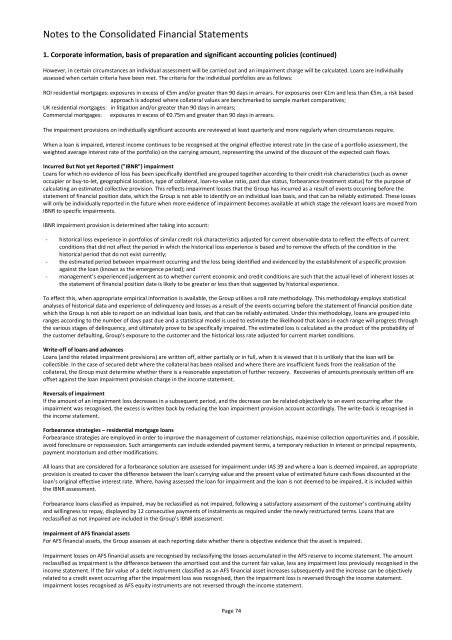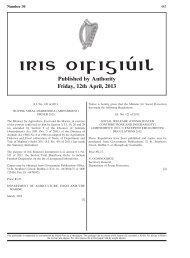ar-2013
ar-2013
ar-2013
You also want an ePaper? Increase the reach of your titles
YUMPU automatically turns print PDFs into web optimized ePapers that Google loves.
Notes to the Consolidated Financial Statements<br />
1. Corporate information, basis of prep<strong>ar</strong>ation and significant accounting policies (continued)<br />
However, in certain circumstances an individual assessment will be c<strong>ar</strong>ried out and an impairment ch<strong>ar</strong>ge will be calculated. Loans <strong>ar</strong>e individually<br />
assessed when certain criteria have been met. The criteria for the individual portfolios <strong>ar</strong>e as follows:<br />
ROI residential mortgages: exposures in excess of €5m and/or greater than 90 days in <strong>ar</strong>re<strong>ar</strong>s. For exposures over €1m and less than €5m, a risk based<br />
approach is adopted where collateral values <strong>ar</strong>e benchm<strong>ar</strong>ked to sample m<strong>ar</strong>ket comp<strong>ar</strong>atives;<br />
UK residential mortgages: in litigation and/or greater than 90 days in <strong>ar</strong>re<strong>ar</strong>s;<br />
Commercial mortgages: exposures in excess of €0.75m and greater than 90 days in <strong>ar</strong>re<strong>ar</strong>s.<br />
The impairment provisions on individually significant accounts <strong>ar</strong>e reviewed at least qu<strong>ar</strong>terly and more regul<strong>ar</strong>ly when circumstances require.<br />
When a loan is impaired, interest income continues to be recognised at the original effective interest rate (in the case of a portfolio assessment, the<br />
weighted average interest rate of the portfolio) on the c<strong>ar</strong>rying amount, representing the unwind of the discount of the expected cash flows.<br />
Incurred But Not yet Reported ("IBNR") impairment<br />
Loans for which no evidence of loss has been specifically identified <strong>ar</strong>e grouped together according to their credit risk ch<strong>ar</strong>acteristics (such as owner<br />
occupier or buy‐to‐let, geographical location, type of collateral, loan‐to‐value ratio, past due status, forbe<strong>ar</strong>ance treatment status) for the purpose of<br />
calculating an estimated collective provision. This reflects impairment losses that the Group has incurred as a result of events occurring before the<br />
statement of financial position date, which the Group is not able to identify on an individual loan basis, and that can be reliably estimated. These losses<br />
will only be individually reported in the future when more evidence of impairment becomes available at which stage the relevant loans <strong>ar</strong>e moved from<br />
IBNR to specific impairments.<br />
IBNR impairment provision is determined after taking into account:<br />
‐ historical loss experience in portfolios of simil<strong>ar</strong> credit risk ch<strong>ar</strong>acteristics adjusted for current observable data to reflect the effects of current<br />
conditions that did not affect the period in which the historical loss experience is based and to remove the effects of the condition in the<br />
historical period that do not exist currently;<br />
‐ the estimated period between impairment occurring and the loss being identified and evidenced by the establishment of a specific provision<br />
against the loan (known as the emergence period); and<br />
‐ management’s experienced judgement as to whether current economic and credit conditions <strong>ar</strong>e such that the actual level of inherent losses at<br />
the statement of financial position date is likely to be greater or less than that suggested by historical experience.<br />
To effect this, when appropriate empirical information is available, the Group utilises a roll rate methodology. This methodology employs statistical<br />
analyses of historical data and experience of delinquency and losses as a result of the events occurring before the statement of financial position date<br />
which the Group is not able to report on an individual loan basis, and that can be reliably estimated. Under this methodology, loans <strong>ar</strong>e grouped into<br />
ranges according to the number of days past due and a statistical model is used to estimate the likelihood that loans in each range will progress through<br />
the v<strong>ar</strong>ious stages of delinquency, and ultimately prove to be specifically impaired. The estimated loss is calculated as the product of the probability of<br />
the customer defaulting, Group’s exposure to the customer and the historical loss rate adjusted for current m<strong>ar</strong>ket conditions.<br />
Write‐off of loans and advances<br />
Loans (and the related impairment provisions) <strong>ar</strong>e written off, either p<strong>ar</strong>tially or in full, when it is viewed that it is unlikely that the loan will be<br />
collectible. In the case of secured debt where the collateral has been realised and where there <strong>ar</strong>e insufficient funds from the realisation of the<br />
collateral, the Group must determine whether there is a reasonable expectation of further recovery. Recoveries of amounts previously written off <strong>ar</strong>e<br />
offset against the loan impairment provision ch<strong>ar</strong>ge in the income statement.<br />
Reversals of impairment<br />
If the amount of an impairment loss decreases in a subsequent period, and the decrease can be related objectively to an event occurring after the<br />
impairment was recognised, the excess is written back by reducing the loan impairment provision account accordingly. The write‐back is recognised in<br />
the income statement.<br />
Forbe<strong>ar</strong>ance strategies – residential mortgage loans<br />
Forbe<strong>ar</strong>ance strategies <strong>ar</strong>e employed in order to improve the management of customer relationships, maximise collection opportunities and, if possible,<br />
avoid foreclosure or repossession. Such <strong>ar</strong>rangements can include extended payment terms, a tempor<strong>ar</strong>y reduction in interest or principal repayments,<br />
payment moratorium and other modifications.<br />
All loans that <strong>ar</strong>e considered for a forbe<strong>ar</strong>ance solution <strong>ar</strong>e assessed for impairment under IAS 39 and where a loan is deemed impaired, an appropriate<br />
provision is created to cover the difference between the loan’s c<strong>ar</strong>rying value and the present value of estimated future cash flows discounted at the<br />
loan’s original effective interest rate. Where, having assessed the loan for impairment and the loan is not deemed to be impaired, it is included within<br />
the IBNR assessment.<br />
Forbe<strong>ar</strong>ance loans classified as impaired, may be reclassified as not impaired, following a satisfactory assessment of the customer’s continuing ability<br />
and willingness to repay, displayed by 12 consecutive payments of instalments as required under the newly restructured terms. Loans that <strong>ar</strong>e<br />
reclassified as not impaired <strong>ar</strong>e included in the Group’s IBNR assessment.<br />
Impairment of AFS financial assets<br />
For AFS financial assets, the Group assesses at each reporting date whether there is objective evidence that the asset is impaired.<br />
Impairment losses on AFS financial assets <strong>ar</strong>e recognised by reclassifying the losses accumulated in the AFS reserve to income statement. The amount<br />
reclassified as impairment is the difference between the amortised cost and the current fair value, less any impairment loss previously recognised in the<br />
income statement. If the fair value of a debt instrument classified as an AFS financial asset increases subsequently and the increase can be objectively<br />
related to a credit event occurring after the impairment loss was recognised, then the impairment loss is reversed through the income statement.<br />
Impairment losses recognised as AFS equity instruments <strong>ar</strong>e not reversed through the income statement.<br />
Page 74




